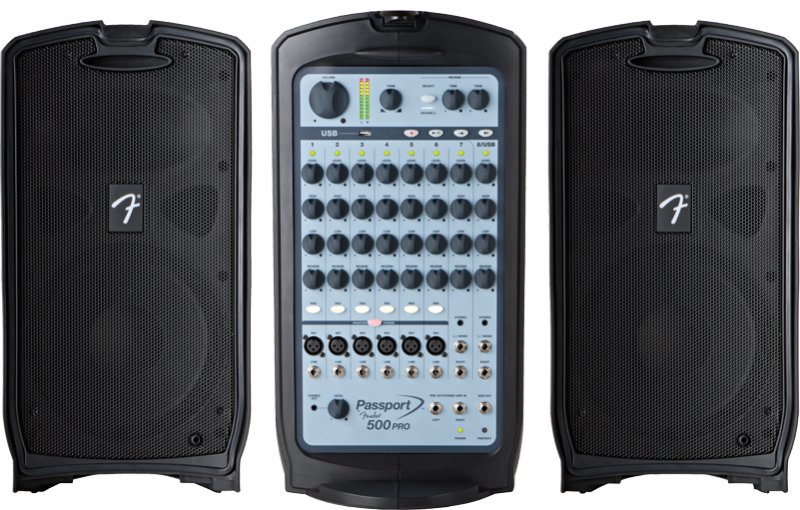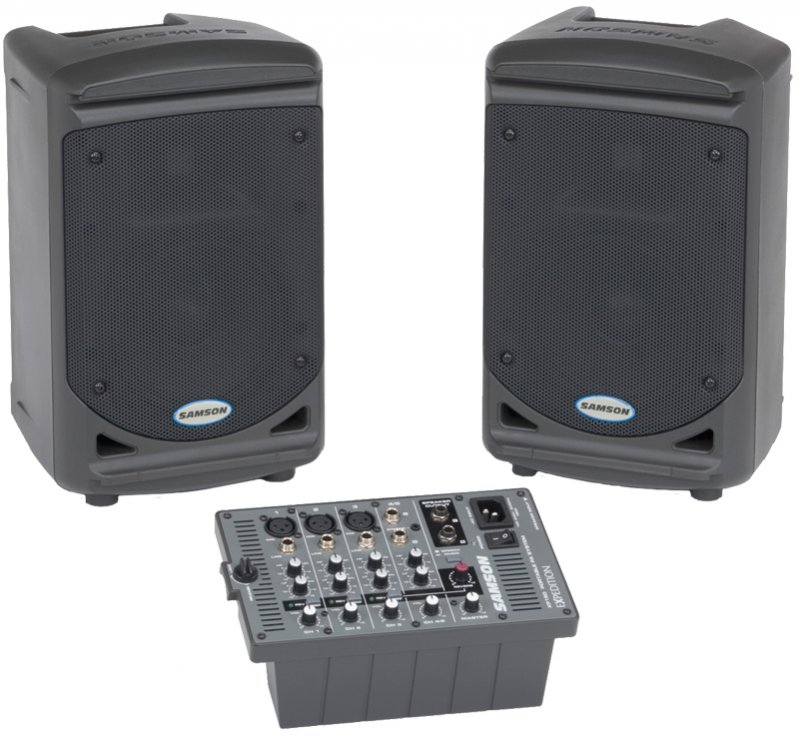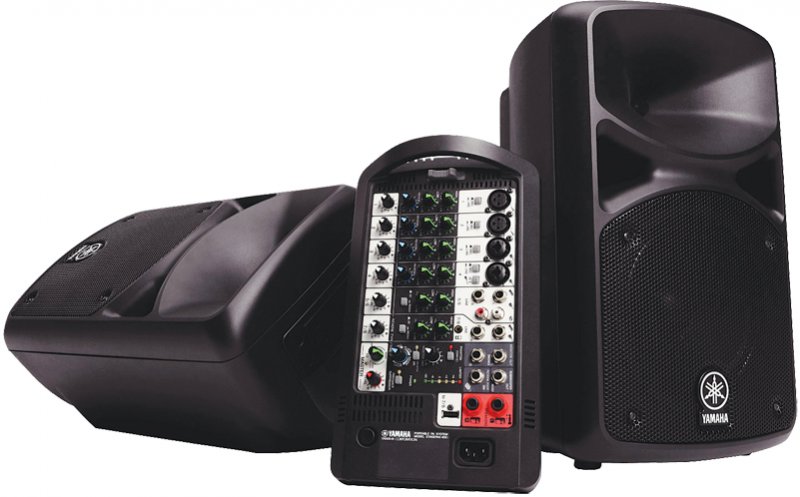Group Review: Four Portable PA Systems On Stage
Group Review: Four Portable PA Systems On Stage
Having done a similar review of portable PA systems for NZM four or five years ago, I was keen to see how advancing technology had changed the world of small-scale public address. As I was about to find out, the gap between sonic heaven and hell is just as wide, but notable progress has been made in portability thanks to the wonders of molded plastic enclosures and ever-lighter amplifier technology. Plus ready recording has become an option. Evolution is a beautiful thing.
As in previous reviews of this kind, I called on the help of a new Bachelor of Recording Arts cohort here at Auckland’s SAE Institute. They were very keen to put the gear to the test, so we locked ourselves away in a dark, windowless studio and cranked up the levels. I should also mention the invaluable assistance Nick Poortman gave during the review process.
All four of these PAs are designed with the one-man/woman act in mind, featuring inputs to cater for vocals, guitars and other instruments, as well as stereo inputs for backing tracks, keyboards or modest DJ applications. Although all of them are designed for stand mounting, the stands themselves are optional extras.
We tested them for their transparency of tone, portability, versatility, user-friendliness, and of course, the all important value for money. So without further ado, let’s start twiddling some knobs.
WHARFEDALE PMX700 System
rrp $899
The UK-based Wharfedale brand is historically associated with home hi-fi equipment, however, for a good 15 years now their pro division has cranked out products for musicians and audio professionals. The PMX range comprises various powered audio mixers while the tag system indicates the additional inclusion of two passive speakers and a hand-held microphone.
With a total weight of over 30kgs and filling the biggest of the boxes that arrived, this was the least portable of the PA systems on test. It was also the only traditional PA featuring wooden speaker enclosures lined with black carpet. The individual components will require at least two trips to the van (or a decent trolley) when you are setting up.
The PMX700 powered mixer has a built-in amplifier that provides 2 x 150W rms into 4Ω (ohms). The whole unit is housed in a rugged plastic hard-shell with a chunky handle. With six microphone inputs and one stereo input – all vertically arranged – this mixer is larger than most of those being reviewed.
Each channel features a phantom-powered XLR socket, a ¼ jack line socket, a three-band EQ, monitor and effects send, and level. There is also a peak indicator, although peaking has to be remedied on the connected instrument because the mixer has no input gain controls. There are no pan controls either, but I doubt anyone would miss them in a PA this size anyway.
The stereo channel labeled as input 7 (rather than 7/8) has two-band EQ, two mono jack inputs and RCA sockets. All the labeling follows accepted industry practices and shouldnt take long to figure out.
The master section features an effects unit, two graphic EQs, an LED indicator section and a line output section. The latter two are straightforward, featuring four-segment LEDs indicating output levels, while two further LEDs indicate the presence of mains and phantom power. There are two jack outputs carrying the left and right line signals, a line signal for an optional floor monitor and very useful RCA outputs to record your performance to a recorder of your choice. Speaker outputs are at the back, providing a choice of Speakon or jack. The included cables are the more budget-conscious, but less secure jack-to-jack connectors.
The 16 included effects are accessed via a rotary knob, and while there is a good choice of staple effects such as reverb, delay, chorus, flange, even Leslie speaker emulation, I didn’t find them particularly inspiring. There was no option to tweak them either, although usefully the effects could be sent to both the main outputs and the optional monitor.
The Graphic EQ section can be connected to the amplifier in two ways, labeled Amp Mode A and B, with a toggle switch to select between the two. Both seven-band graphic EQs control the left and right outputs in Mode A, while the top graphic EQ can be stolen to control the monitor output in Mode B. In this case, the bottom graphic EQ will control both left and right outputs. This is not as effective as a feedback eliminator but can make a difference when you try to keep nasty feedback in check manually.
The carpeted speakers are taken from Wharfedale’s PT range and have been paired with the mixer for this combo product. Equipped with a compression driver for the highs and a 12 woofer rated at 250W continuous, they have a trapezoid shape to allow forming an array for wider dispersion of the sound when using multiple speakers. Of course, they also tilt back usefully when used as floor monitors.
In conclusion, this system will be familiar to musicians who have used small PAs in the past. There is a classic feel about it, from the speaker lining to the mixer features. When we tested it with music, guitar and vocals, we were tempted to utilise the graphic EQ to tweak the overall tonality rather than use it to combat feedback, because the sound had a coloured and slightly distant quality about it that we couldnt manage to fix with the channel EQ.
The built-in effects left me struggling to find a usable setting and wished for more tweak-ability. The extra channels, on the other hand, might be very welcome when jamming with friends. All in all, given the very attractive price point of $899 and the inclusion of a vocal mic, the Wharfedale would be a contender for a small ensemble on a tight budget.
Tone 2/5, Portability 3/5, Versatility 4/5
Value for Money 3/5
FENDER Passport 500 Pro
rrp $1899
The Fender name has a ring of history and grandeur, so expectations for this model were high. The Passport 500 Pro resembles a hard-shell suitcase, with a nifty cut-out to accommodate the shape of your legs when you carry it. Classy! It is reasonably heavy, but not impossible to carry with one hand, leaving the other to carry your guitar or give autographs.
After undoing the latches two speakers and a powered column mixer are revealed. The speakers connect to the mixer via angled jack plugs at the bottom of their curved front. While this looks like an aesthetically pleasing solution, in terms of safety it isnt ideal. With no secure locking mechanism, the jacks are too exposed and can easily become undone accidentally.
The column mixer is again an aesthetic miracle with large rubber knobs and buttons. In use, however, they can be a bit frustrating because of their rudimentary labeling. There is a simple small dot for minimum and a large dot for maximum, but no meaningful reference in between. Having said that, when operated by a musician on a dark stage the large layout is convenient and makes a lot of sense.
Six mono channels with XLR/jack inputs and two stereo channels with standard jack and mini-jack options are featured, all of them equipped with two-band EQ, a reverb send and a level. The mono channels additionally can be phantom-powered globally and feature a PAD – quite useful when miking drums. Just above the mixer, there is a USB input that allows a flash drive to be connected to stereo channel 8 for playback, also allowing you to easily record any performance at CD quality, with the help of four transport controls next to the USB port.
The upper part of the mixer contains the main level control, a tone contour knob that allows either highs or lows to be rolled off depending on which way you turn it, and a reverb with two tasteful algorithms – studio and hall – and adjustable tone and decay time.
The lower part has an effects loop similar to those found on guitar amplifiers, albeit in stereo, and a subwoofer output with a built-in crossover point at 120Hz that only becomes active when a cable is plugged into the socket. There is also a built-in limiter that lights up a protect LED when active. As a further useful addition, a mini-jack carries the left and right signal, should you wish to record to anything other than the USB flash drive.
Powered by a mighty 2 x 250W amplifier, the speakers are fitted with a 10 woofer and a 1.2 horn-loaded driver. Due to their oddly curved shape they felt a little unstable on a flat surface, although they never really fell over. I suggest mounting them on stands for more secure operation and better projection. They had both pleasing highs and weighty lows, however, I struggled to hear enough midrange information. Oddly enough for a Fender product, guitars were a particular problem, lacking in body and tone. Unfortunately this issue couldn’t really be tackled with the tone contour knob, either.
Altogether this nifty PA has it all when it comes to portability and aesthetics. Some of the design features might seem a bit gimmicky to some while others will dig their unique character. We all agreed that the retail price of $1899 seems a bit high when compared with the other models on review, but again, with six pre-amps, small ensembles will be well-catered for, and if everyone chips in the Fender Passport is equipped to deal with most of the things you may throw at it.
Tone 3/5, Portability 3/5, Versatility 4/5
Value for Money 3/5
SAMSON Expedition XP150
rrp $599
Given its lower price point and diminutive size – you could fit about four of these Samson PAs into the Wharfedale’s cardboard box – this Samson PA was seen as the underdog of the review. The XP150 has a mere 75 watts per side, half the power of the Wharfedale and close on a quarter of the Fender. However, Samson’s Expedition proved to punch well above its weight.
The first thing that struck us was the ultra-compact design. You can truly carry this PA in one hand without any struggle. This is possible thanks to a sliding rail that allows the speakers to interlock with one another, containing the miniature mixer in the back of one speaker while all the cables fit into the back of the other. Although the handle is slightly off-centre when carried around, the whole unit only weighs in at approximately 12kg, so you could easily carry two of these PAs at once.
The mixer features three channels with XLR and ¼ inputs, just enough to allow a mate to join you on stage. It also includes one stereo ¼ and mini-jack input channel for connecting MP3 players, keyboards and more. Each channel features a level control and 2-band EQ controls.
The mono channels also allow reverb to be assigned via a button, with the overall level controlled from the master section. A rotary pot as opposed to a button would have made quite a difference here. The reverb cannot be changed and is set to some odd double slapback delay, not really a reverb at all. Turning it up just a fraction too much quickly turns it into an irritating rather than a helpful feature.
The only other controls in the master section are the overall master level and a high pass filter labeled speech/music. A power presence LED doubles as a level indicator, turning orange and then red as output level reaches clipping point. There are two output jacks connecting the speakers. The IEC power socket was placed here as well to sensibly allow the mixer to stay in the back of the speaker during operation.
Powering music, vocals and instruments through the 6 two-way speakers revealed a surprising efficiency, and although the two lower octaves were missing – not a surprise at this enclosure size – the midrange and highs were rather detailed and pleasant, with only a hint of low mid resonance and hyped top end.
The Samson XP150 speakers have stand mounts, but they’re also shaped to tilt back when used as floor monitors. At the very low price point of $599 and with their limited feature set and power, this is where I really see them adding to musicians needs. They would certainly be loud enough on a small stage.
Tone 4/5, Portability 5/5, Versatility 3/5
Value for Money 4/5
YAMAHA StagePas 400i
rrp $1699
The brand Yamaha instills confidence by the mere fact that this Japanese giant has supplied consistently reputable equipment for over 125 years. Unpacking the StagePas box, we found two molded plastic passive bass reflex enclosures fitted with lightweight 8 woofers and 1 compression drivers. They come with a stand mount, and are molded to work equally well as floor monitors.
Similar to the Samson set, each speaker has a storage compartment at the back, one containing the powered mixer and the other containing the speaker and power cables. Unlike the Samson’s, there is no provision to attach the speakers to one another for transport. However, picking them up by their deep handles and carrying one in each hand is as comfortable as anything. The whole package weighs in at less than 18 kg, including the mixer. You have to ask how they do this. Heck, my pedal board weighs more!
The mixer can be detached or operated from the back of the speaker. It features four mono channels of which 1 and 2 feature XLR inputs, while 3 and 4 have Neutrik combo connectors providing inputs for either XLR or jack leads. All four channels are switchable between mic and line level inputs, but only channels 1 and 2 receive phantom power. The jack input on channel 4 surprises you with a Hi Z switch, making this the only PA in this review with a built-in high impedance instrument input. You will also find a simple two-band EQ, a reverb send and the channel level control.
Two stereo channels allow connection of keyboards and drum machines via the usual instrument jacks. The first stereo channel (5/6) also features RCA inputs while the second channel (7/8) boasts a USB as well as mini-jack input option. They can also both be turned into mono channels and feature the same EQ as the mono channels. Sadly, you cannot access the reverb send from these channels. This is odd, considering they are marked as instrument inputs.
The master section is equally impressive, featuring the left and right speaker outputs (in cautionary red colour to alert you to the speaker power level coming from these sockets) as well as a stereo line level monitor output, a subwoofer out for optional expansion, and even a reverb foot switch.
The signal processing in the master section is absolutely stunning and leaves the other reviewed units looking rather pale in comparison. Besides the variable tone contour knob that dials between speech, music and bass boost, there is also a very effective automatic feedback suppressor with a simple on switch and associated LED. When put to the test, both these features proved to be very handy and extremely well-designed.
The other powerhouse in this section is the built-in reverb processor. It packs a very versatile four basic reverb algorithms into a single rotary control, while still being adjustable, and most importantly, taken from Yamahas own SPX range they all sound tasty and useful. One minor quibble is the absence of a detent where the rotary control transitions from one reverb to another.
All the features add up to an impressive set, but what impressed us most was the sound. No matter what signal we threw at the StagePas, there was punch and clarity all the way from the low end to the highs. I personally liked to help the bass with the tone contour in the master section set to two oclock when playing pre-recorded music. This gave the bass an added warmth and fullness.
While at $1699 this StagePas is among the more costly options, we all agreed that your money would be extremely well spent as this PA has the potential to make a great performer sound great too.
Tone 5/5, Portability 4/5, Versatility 4/5
Value for Money 5/5
Karsten Schwardt is a lecturer in Audio Engineering at SAE Institute in Auckland and holds a Bachelor (Hons) in Recording Arts. In his spare time he can be found recording and mixing in his project studio The Tunne, or playing in The Electric Era (www.theelectricera.com). He can be reached at k.schwardt@sae.edu. Special thanks to Nick Poortman of SAE Auckland who assisted in this review.




